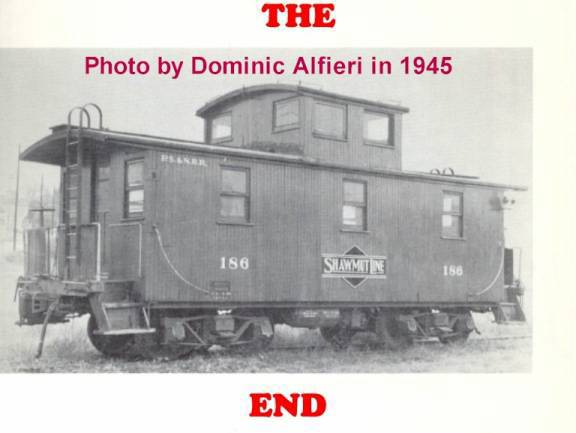The
Pittsburg
Shawmut and Northern Railroad
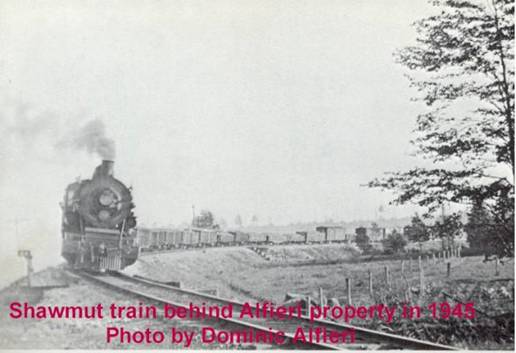
The Shawmut train traveling
North on the track directly behind the Alfieri property in Clermont is shown
here.
The Pittsburg
Shawmut and Northern Railroad played
a very important part in the history
of Clermont. More
More commonly known to most of us as the
“Shawmut”, it had a couple less known names.
Some old timers referred to it as the “Mutt” and
at times" Pretty Slow & Noisy" for the P.S. & N.
This
railroad was organized on August 2, 1899 Railroad tracks where it was
transferred to the
Erie
lines to markets in the east. With
the help of a good number of Italian workmen completed the segment of
road from Kasson to Clermont to connect with the old
Buffalo
, St Marys & Southwestern segment of the Shawmut. This included the
famous Kasson loop. Several excellent books about the “Shawmut” have been
written and are readily available. Therefore my
discussion will be focused on the local employees and that portion of the
line that was located in the Clermont vicinity.
My personal experience as a former employee of this railroad and my
acquaintance with other employees of the line are useful in this endeavor. The
section of track that was considered the "Clermont Section" ran
from Kasson through Clermont to
North Fork
. Of course the famous "
Loop
de Loop" which was officially called the Kasson loop was located in
this section. To us employees it was simply the "
Loop
". An interesting note about the loop and a Clermont resident is
that Fred Anderson was a stonemason and helped construct the tunnels for
the stream that ran under the loop. Of course it is noted that Fred
Anderson was one of the local Clermont farmers.
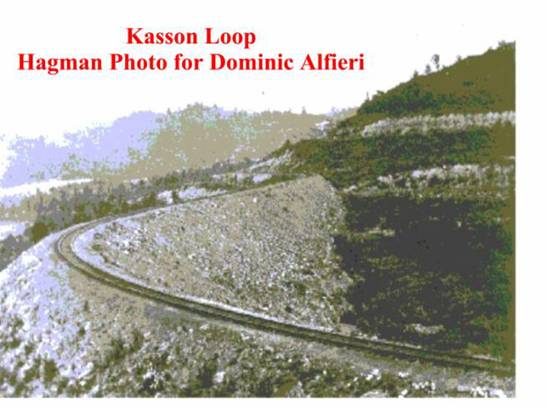
The Kasson Loop was built with the help of a great number of
Italian workmen in 1909. This section of track joined the section from St Marys
in Clermont. The loop was officially
opened with a big ceremony including a band that year as shown in the following
photo.
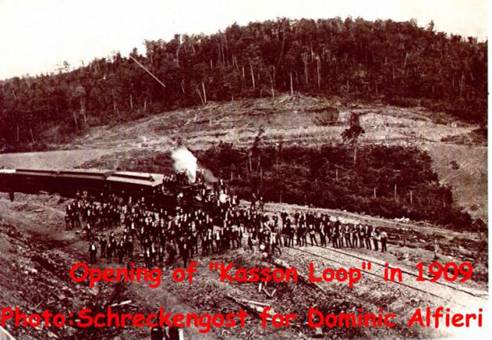
The main
locations of the section, often called stations were Kasson, Palmerville,
Clermont, Dale (also called Chatham), Three Mile, Five Mile, Wellendorf, Straight
Creek, Wildwood, and North Fork. Wellendorf
was named after B. E.Wellendorf from St Marys who was chief engineer with the
railroad. Wildwood is also well known for the state fire tower that was
located there.
Chatham
more commonly known as Dale was located about a mile south of Clermont.
See photograph below:

Dale
was unique in that a water tank was located there where the locomotives stopped
to get water for the steam engines. There
was building along the side of the tank that housed the natural gas driven
engine for pumping the water from a deep well to fill the huge tank.
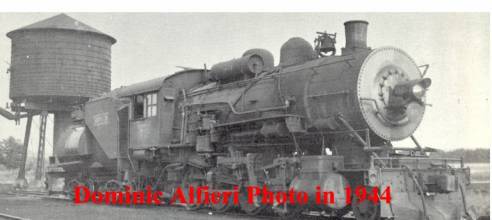
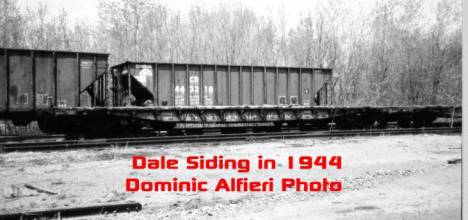
The
siding located at Dale was used mostly for unloading creosote ties, rails, and
other materials needed to maintain the tracks. There
was also a siding at Wellendorf which was used mostly to re-arrange cars on a
train or to leave cars to be picked up by a later train.
It also served as a parking area for an engine, handcar, or a motorcar to
wait for a train to go by at a certain time.
Both sidings had oil signal lamps for night use of the sidings. In the
winter after the train with a snowplow went by the siding switches had to be
cleaned.
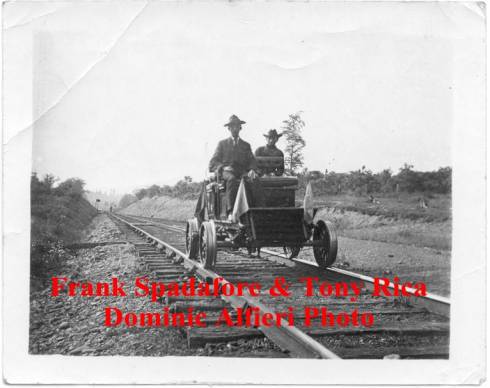
Photo
Credit Hagman collection
Prior to the organization and extension of the
P. S. & N. through Clermont people who wanted to travel to
Olean
would use the
Pennsylvania
railroad. With the arrival of the
Shawmut a one-passenger train called the “ Hootle Bug” was introduced to
enable people to go to Smethport and points beyond. Local residents fondly
called it the” Hooty Bug”.
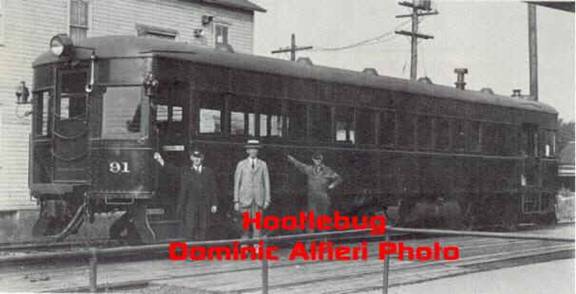
Maintenance of its railroad bed is vital to any
railroad. For the Clermont section
of the P.S. & N. a crew consisting of a foreman and 4 or 5 men was employed.
From the early years until final days of the line a Spadafore was
employed. In the early years Frank Spadafore was the foreman.
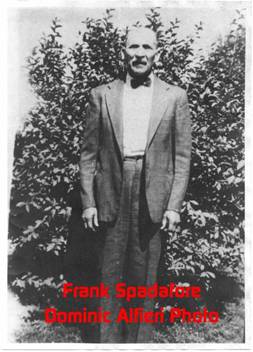
Some of
the employees were: Frank Feragine, Frank Miniaci, Tony Spadafore, and
Vernon Swanson. Later Some of the employees were Tony Rica, Mike Spadafore, Bruno
Muzzi,and Dominic Feragine. One of his younger sons Jim Spadafore came to work for
him in the 1930's. Upon Frank’s retirement Jim Spadafore became the foreman.
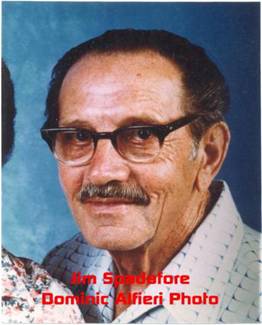
The rest
of the crew was John Palumbo, Glenn Snyder, and
Vernon
Swanson. In the summer of 1943 I
worked as a temporary employee at 32 cents an hour. The work on the section
consisted of maintaining the roadbed. Old ties were replaced as needed. Ditches
along the roadbed were kept clean. The ride way was mowed with scythes during
the summer months .One constant need was to raise low parts of the track and
tamp under the ties for proper height. Below
is a picture of a jack used to raise ties on the Shamut during the 1940’s.
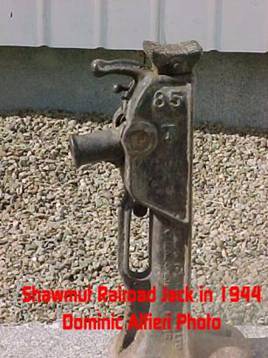
The regular men made 35 cents per hour. Harold
Hagman was hired as a full time employee in the fall when I returned to high
school. In early 1944 Harold got a
job in the
Bradford
oil fields so I was hired as a full time employee. Early in 1945 I was drafted
into the
U. S.
Army and so the crew was only 4 again. In the summer of 1946 the other men were
laid off except for the foreman. Upon
my discharge from the army in late 1946 the railroad was required by law to give
me back my job. In March of 1947
Harry W. Findley purchased the road and prepared to dismantle it. Consequently I
was also laid off but Jim Spadafore was kept on to work with the dismantling
group.
The only reason for this railroad in the first place was to haul
coal out of the mines of
Pennsylvania
to the markets in the North and East. After
World War II, the main business of the railroad, its coal business, began to
fall off. Since it had failed to pay interest on money during the years of
construction, it had entered into receivership. It was actually bankrupt from
the beginning but was allowed to operate under a receiver appointed by a court.
In fact the railroad was in receivership longer than any railroad company in the
history of these
United States
. The last train of the
Pittsburg
, Shawmut & Northern ran on April 1, 1947.
